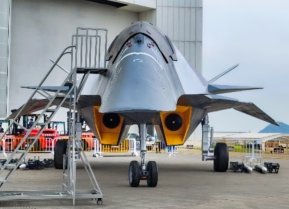$125,000,000,000 Sentinel ICBM Nightmare Has Arrived
The U.S. government is dropping the proverbial ball—all while American foes quickly catch up. Deterrence is indeed dead.
Deterrence is dead. It has been allowed to wither away to nothing really since the end of the Cold War, when everyone in Washington (and throughout the West) simply assumed that history was over. Even after that thesis was made false, many policymakers and strategists in Washington assumed that, while conflict would remain part of the post-Cold War era, such wars would only be small counterinsurgency and counterterrorism-type campaigns.

Nukes, barring the threat from the odd rogue state, were a thing of the past.
Well, the rest of the world did not get that message. In fact, the Russians spent much of the twenty-first century rehabilitating their nuclear force that had been gutted by the collapse of the Soviet Union and the end of the Cold War.
Moscow then extracted an incredible concession from former President Barack Obama that allowed Russia to rapidly modernize its nuclear arsenal and to create a superior arsenal of non-strategic nuclear weapons with the New START Treaty. The Americans, meanwhile, went about downgrading the strategic importance of their nuclear weapons arsenal.
A New ICBM for America
When Donald Trump was first elected in 2016, though, these changes reversed. Moves were made by the then-forty-fifth president to modernize and expand America’s ailing nuclear weapons arsenal. Much work was done by that administration to go about replacing aging systems, such as the Minuteman III Ground-Based Strategic Deterrent (GBSD). By 2020, after much hemming-and-hawing, the Air Force awarded the development contract for a new GBSD to Northrop Grumman.
The Sentinel intercontinental ballistic missile (ICBM) program was launched at that point.
And it could not have come at a better time. After all, the 2020s have seen an unprecedented upsurge in the development of other nuclear arsenals belonging to American rivals, aside from just Russia.
Notably, the People’s Republic of China has been on a nuclear weapons building spree.
In fact, there is much debate among Western analysts regarding the true size and capabilities of China’s nuclear arsenal simply because China was never a party to the now-scuttled Intermediate-Range Nuclear Forces (INF) Treaty that was signed between the United States and the former Soviet Union in the 1980s. So, both Russia and the United States curbed their arsenals according to that treaty, but China never signed the INF.
Anyway, the other nuclear threats to America, North Korea and Iran, have both made considerable strides in developing the complexity of their nuclear arsenals as well as the delivery systems. All this means is that the United States desperately needs to expand its own arsenal to restore that last deterrence. The Sentinel GBSD program of replacing aging Minuteman III nukes with newer Sentinel ICBMs is a necessary pathway forward.
An Innovative Design…for Armageddon
What’s more, the Sentinel ICBM’s design is quite innovative. It is modular, allowing for easier upgrades that potentially extend its service life through the 2070s. The Sentinel’s components will be replaced as technology evolves in that timeframe, ensuring the missile’s relevance against future threats as well as current ones. Further, Sentinel ICBMs will incorporate state-of-the-art guidance systems, allowing these systems to have greater precision and reliability.
Oh, and since we live in a truly unique time, the Sentinels are armed with robust cybersecurity countermeasures. These defenses are not accounted for in the current Minuteman III ICBMs, which were all built beginning in the 1970s.
America’s nuclear deterrence depends upon its nuclear triad. With the aging Minuteman III ICBMs as the basis of the ground-based leg of the triad, America was vulnerable. The Sentinel ICBM force, however, enhances America’s failing deterrence for the next fifty years. It complicates an adversary’s ability to neutralize America’s nuclear forces in a first strike.
Beyond that, the Sentinel ICBMs are a believable—and visible—form of instant deterrence. They are stationed in silos that are easily identified by enemy nations. But their visibility and constant presence, paired with the reliable second-strike capabilities of America’s nuclear submarine force, as well as the flexibility of its nuclear bomber fleet, all add to the invincibility of the United States in the face of a nuclear war.
With a new Trump administration taking over with the double mandate of making a comprehensive geopolitical deal with the Russian Federation, the likelihood of arms control talks at least with Moscow increases.
By developing the Sentinel ICBM, an advanced and robust—highly destructive—nuclear weapon, the Americans will have unprecedented leverage over the Russians (and other possible negotiating counterparts) in those possible arms control talks.
That Old Potomac Problem Set…
As with any defense project these days, there are many downsides on the technical side. For instance, initial cost projections had this project costing around $95 billion. Yet, in typical fashion, costs have exploded by an astonishing 37 percent (bringing the program to well over $125 billion). Because of this cost overrun, the Nunn-McCurdy Act was triggered, which was created to try to limit these excesses in the management of expensive, complex defense projects.
Now, the program might be significantly restructured or even, sadly, canceled.
Not only are the cost overruns killing the program, but they’ve also now stalled schedule. Originally scheduled for 2025, the first test flight has been kicked back to 2026. I’m sure America’s adversaries will wait for the Americans to get their act together.
Oh, and then there’s the continual debate over whether these systems are even necessary for deterrence (with doves arguing that they actually prompt escalation).
Lost in all these discussions is the need for both enhancing America’s nuclear weapons deterrent as well as building space-based missile defenses of the kind that President Ronald Reagan wanted with the Strategic Defense Initiative (SDI), so that ultimately these nuclear weapons were simply rendered obsolete.
Alas, without a reliable space-based missile defense, more nukes will be needed. And even in that area, the U.S. government is dropping the proverbial ball—all while American foes quickly catch up. Deterrence is indeed dead.
Once America’s foes realize that sad truth, what’s to stop them from acting on that newfound reality?
About the Author
Brandon J. Weichert, a National Interest national security analyst, is a former Congressional staffer and geopolitical analyst who is a contributor at The Washington Times, the Asia Times, and The-Pipeline. He is the author of Winning Space: How America Remains a Superpower, Biohacked: China’s Race to Control Life, and The Shadow War: Iran’s Quest for Supremacy. His next book, A Disaster of Our Own Making: How the West Lost Ukraine, is available for purchase wherever books are sold. Weichert can be followed via Twitter @WeTheBrandon.
Image Credit: Creative Commons.


